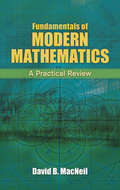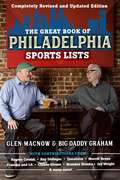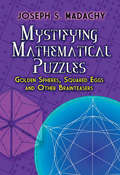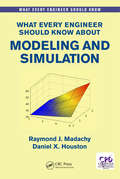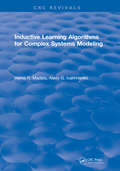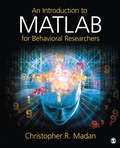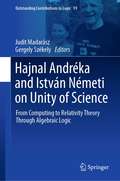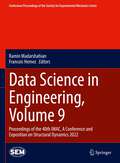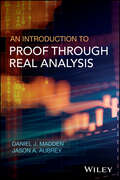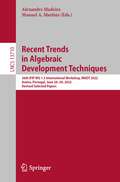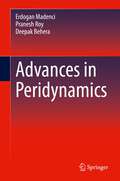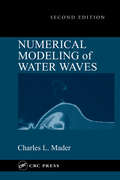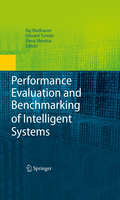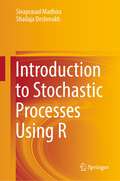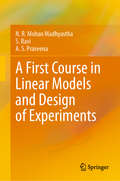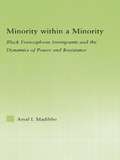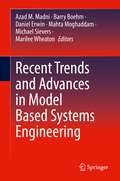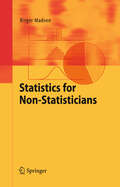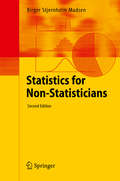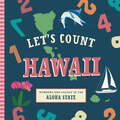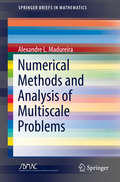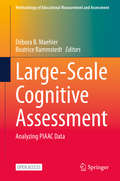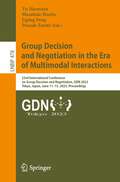- Table View
- List View
Fundamentals of Modern Mathematics: A Practical Review (Dover Books on Mathematics)
by David B. MacNeilStudents and others wishing to know a little more about the practical side of mathematics will find this volume a highly informative resource. An excellent supplement to college and high school courses as well as a guide to independent study, the book covers examples of pure mathematics as well as concepts of applied mathematics useful for solving problems that arise in business, industry, science, and technology.Contents include examinations of the theory of sets, numbers and groups; matrices and determinants; probability, statistics, and quality control; and game theory. Additional subjects include inequalities, linear programming, and the transportation problem; combinatorial mathematics; transformations and transforms; and numerical analysis. Accessible explanations of important concepts feature a total of more than 150 diagrams and graphs, in addition to worked-out examples with step-by-step explanations of methods. Answers to exercises and problems appear at the end.
The Great Book of Philadelphia Sports Lists (Completely Revised and Updated Edition)
by Glen Macnow Big Daddy GrahamWhen it comes to sports talk, no city has more to say than Philadelphia.With their 2007 The Great Book of Philadelphia Sports Lists, WIP sports radio hosts Glen Macnow and Big Daddy Graham compiled dozens of sports lists to stir up dialog and debate within the buzzing Philadelphia sports community (and beyond).A lot has happened in Philly sports since 2007 -- the Phillies' 2008 World Series win; the Eagles' record-breaking 2017 season, now-famous Philly Special play, and Super Bowl LII victory over the Patriots; the Sixers' "Trust the Process" campaign; and, of course, Gritty -- so now Glen and Big Daddy are back with dozens of new lists to keep the conversation fresh, ranking things like:The most overrated and underrated players in Philly sports historyThe top 10 Philadelphia sports quotesThe 10 worst Eagles draft picks everThe greatest duos in Philly sports historyThe 10 best sports movies set in PhiladelphiaThe worst bosses in Philly sports historyand much more!
Mystifying Mathematical Puzzles: Golden Spheres, Squared Eggs and Other Brainteasers
by Joseph S. Madachy"Fans will find this volume indispensable; casual readers will find it an attractive nuisance," observed The Scientific American of this rich and challenging compilation of puzzles. From brainteasers that any novice can figure out to complex problems involving number theory, this puzzle treasury offers a splendid variety of conundrums. Readers can follow the path of the bouncing billiard balls, search for the lost chord, size up golden spheres, calculate the number of squared eggs, and take on dozens of other imaginative challenges, including diabolic squares, flexagons, domino games, and geometric dissections. Assembled by Joseph S. Madachy, lead editor of the Journal of Recreational Mathematics, this collection features problems as well as classical puzzles, many of which offer fascinating insights into the nature of mathematics. Mystifying Mathematical Puzzles provides excellent entertainment for puzzle enthusiasts of every level and is ideal for home or classroom use. Complete solutions to all puzzles are included.
What Every Engineer Should Know About Modeling and Simulation (What Every Engineer Should Know)
by Raymond J. Madachy Daniel HoustonThis practical book presents fundamental concepts and issues in computer modeling and simulation (M&S) in a simple and practical way for engineers, scientists, and managers who wish to apply simulation successfully to their real-world problems. It offers a concise approach to the coverage of generic (tool-independent) M&S concepts and enables engineering practitioners to easily learn, evaluate, and apply various available simulation concepts. Worked out examples are included to illustrate the concepts and an example modeling application is continued throughout the chapters to demonstrate the techniques. The book discusses modeling purposes, scoping a model, levels of modeling abstraction, the benefits and cost of including randomness, types of simulation, and statistical techniques. It also includes a chapter on modeling and simulation projects and how to conduct them for customer and engineer benefit and covers the stages of a modeling and simulation study, including process and system investigation, data collection, modeling scoping and production, model verification and validation, experimentation, and analysis of results.
Inductive Learning Algorithms for Complex Systems Modeling
by H.R. MadalaInductive Learning Algorithms for Complex Systems Modeling is a professional monograph that surveys new types of learning algorithms for modeling complex scientific systems in science and engineering. The book features discussions of algorithm development, structure, and behavior; comprehensive coverage of all types of algorithms useful for this subject; and applications of various modeling activities (e.g., environmental systems, noise immunity, economic systems, clusterization, and neural networks). It presents recent studies on clusterization and recognition problems, and it includes listings of algorithms in FORTRAN that can be run directly on IBM-compatible PCs. Inductive Learning Algorithms for Complex Systems Modeling will be a valuable reference for graduate students, research workers, and scientists in applied mathematics, statistics, computer science, and systems science disciplines. The book will also benefit engineers and scientists from applied fields such as environmental studies, oceanographic modeling, weather forecasting, air and water pollution studies, economics, hydrology, agriculture, fisheries, and time series evaluations.
An Introduction to MATLAB for Behavioral Researchers
by Christopher R. MadanMATLAB is a powerful data analysis program, but many behavioral science researchers find it too daunting to learn and use. An Introduction to MATLAB for Behavioral Researchers by Christopher R. Madan is an easy-to-understand, hands-on guide for behavioral researchers who have no prior programming experience. Written in a conversational and non-intimidating style, the author walks students—step by step—through analyzing real experimental data. Topics covered include the basics of programming, the implementation of simple behavioral analyses, and how to make publication-ready figures. More advanced topics such as pseudo-randomization of trial sequences to meet specified criteria and working with psycholinguistic data are also covered. Interesting behavioral science examples and datasets from published studies, such as visualizing fixation patterns in eye-tracking studies and animal search behavior in two-dimensional space, help develop an intuition for data analysis, which is essential and can only be developed when working with real research problems and real data.
Hajnal Andréka and István Németi on Unity of Science: From Computing to Relativity Theory Through Algebraic Logic (Outstanding Contributions to Logic #19)
by Judit Madarász Gergely SzékelyThis book features more than 20 papers that celebrate the work of Hajnal Andréka and István Németi. It illustrates an interaction between developing and applying mathematical logic. The papers offer new results as well as surveys in areas influenced by these two outstanding researchers. They also provide details on the after-life of some of their initiatives.Computer science connects the papers in the first part of the book. The second part concentrates on algebraic logic. It features a range of papers that hint at the intricate many-way connections between logic, algebra, and geometry. The third part explores novel applications of logic in relativity theory, philosophy of logic, philosophy of physics and spacetime, and methodology of science. They include such exciting subjects as time travelling in emergent spacetime. The short autobiographies of Hajnal Andréka and István Németi at the end of the book describe an adventurous journey from electric engineering and Maxwell’s equations to a complex system of computer programs for designing Hungary’s electric power system, to exploring and contributing deep results to Tarskian algebraic logic as the deepest core theory of such questions, then on to applications of the results in such exciting new areas as relativity theory in order to rejuvenate logic itself.
Data Science in Engineering, Volume 9: Proceedings of the 40th IMAC, A Conference and Exposition on Structural Dynamics 2022 (Conference Proceedings of the Society for Experimental Mechanics Series)
by Ramin Madarshahian Francois HemezData Science in Engineering, Volume 9: Proceedings of the 40th IMAC, A Conference and Exposition on Structural Dynamics, 2022, the nineth volume of nine from the Conference brings together contributions to this important area of research and engineering. The collection presents early findings and case studies on fundamental and applied aspects of Data Science in Engineering, including papers on:Novel Data-driven Analysis MethodsDeep Learning Gaussian Process AnalysisReal-time Video-based AnalysisApplications to Nonlinear Dynamics and Damage DetectionHigh-rate Structural Monitoring and Prognostics
Limited-dependent and Qualitative Variables in Econometrics
by G. S. MaddalaThis book presents the econometric analysis of single-equation and simultaneous-equation models in which the jointly dependent variables can be continuous, categorical, or truncated. Despite the traditional emphasis on continuous variables in econometrics, many of the economic variables encountered in practice are categorical (those for which a suitable category can be found but where no actual measurement exists) or truncated (those that can be observed only in certain ranges). Such variables are involved, for example, in models of occupational choice, choice of tenure in housing, and choice of type of schooling. Models with regulated prices and rationing, and models for program evaluation, also represent areas of application for the techniques presented by the author.
An Introduction to Proof through Real Analysis
by Daniel J. Madden Jason A. AubreyAn engaging and accessible introduction to mathematical proof incorporating ideas from real analysis A mathematical proof is an inferential argument for a mathematical statement. Since the time of the ancient Greek mathematicians, the proof has been a cornerstone of the science of mathematics. The goal of this book is to help students learn to follow and understand the function and structure of mathematical proof and to produce proofs of their own. An Introduction to Proof through Real Analysis is based on course material developed and refined over thirty years by Professor Daniel J. Madden and was designed to function as a complete text for both first proofs and first analysis courses. Written in an engaging and accessible narrative style, this book systematically covers the basic techniques of proof writing, beginning with real numbers and progressing to logic, set theory, topology, and continuity. The book proceeds from natural numbers to rational numbers in a familiar way, and justifies the need for a rigorous definition of real numbers. The mathematical climax of the story it tells is the Intermediate Value Theorem, which justifies the notion that the real numbers are sufficient for solving all geometric problems. • Concentrates solely on designing proofs by placing instruction on proof writing on top of discussions of specific mathematical subjects • Departs from traditional guides to proofs by incorporating elements of both real analysis and algebraic representation • Written in an engaging narrative style to tell the story of proof and its meaning, function, and construction • Uses a particular mathematical idea as the focus of each type of proof presented • Developed from material that has been class-tested and fine-tuned over thirty years in university introductory courses An Introduction to Proof through Real Analysis is the ideal introductory text to proofs for second and third-year undergraduate mathematics students, especially those who have completed a calculus sequence, students learning real analysis for the first time, and those learning proofs for the first time. Daniel J. Madden, PhD, is an Associate Professor of Mathematics at The University of Arizona, Tucson, Arizona, USA. He has taught a junior level course introducing students to the idea of a rigorous proof based on real analysis almost every semester since 1990. Dr. Madden is the winner of the 2015 Southwest Section of the Mathematical Association of America Distinguished Teacher Award. Jason A. Aubrey, PhD, is Assistant Professor of Mathematics and Director, Mathematics Center of the University of Arizona.
Recent Trends in Algebraic Development Techniques: 26th IFIP WG 1.3 International Workshop, WADT 2022, Aveiro, Portugal, June 28–30, 2022, Revised Selected Papers (Lecture Notes in Computer Science #13710)
by Alexandre Madeira Manuel A. MartinsThis book constitutes the thoroughly refereed post-conference proceedings of the 26th International Workshop on Algebraic Development Techniques, WADT 2022, held in Aveiro, Portugal, in June 2022.The 6 revised papers presented together with 2 invited papers were carefully reviewed and selected from 25 submissions. The contributed presentations covered a range of topics about the algebraic approach to system specification, which encompasses many aspects of the formal design of software systems. Originally born as formal method for reasoning about abstract data types, the algebraic approach now covers new specification frameworks and programming paradigms (such as object-oriented, aspect-oriented, agent-oriented, logic, and higher-order functional programming) as well as a wide range of application areas (including information systems, concurrent, distributed, and mobile systems).
Advances in Peridynamics
by Erdogan Madenci Pranesh Roy Deepak BeheraThis book presents recent improvements in peridynamic modeling of structures. It provides sufficient theory and numerical implementation helpful to both new and existing researchers in the field. The main focus of the book is on the non-ordinary state-based (NOSB) peridynamics (PD) and its applications for performing finite deformation. It presents the framework for modeling high stretch polymers, viscoelastic materials, thermoelasticity, plasticity, and creep. It provides a systematic derivation for dimensionally reduced structures such as axisymmetric structures and beams. Also, it presents a novel approach to impose boundary conditions without suffering from displacement kinks near the boundary. Furthermore, it presents refinements to bond-based PD model by including rotation kinematics for modeling isotropic and composite materials. Moreover, it presents a PD – FEM coupling framework in ANSYS based on principle for virtual work. Lastly, it presents an application of neural networks in the peridynamic (PINN) framework. Sample codes are provided for readers to develop hands-on experience on peridynamic modeling. Describes new developments in peridynamics and their applications in the presence of material and geometric nonlinearity; Describes an approach to seamlessly couple PD with FE; Introduces the use of the neural network in the PD framework to solve engineering problems;Provides theory and numerical examples for researchers and students to self-study and apply in their research (Codes are provided as supplementary material);Provides theoretical development and numerical examples suitable for graduate courses.
Numerical Modeling of Water Waves
by Charles L. MaderNumerical Modeling of Water Waves, Second Edition covers all aspects of this subject, from the basic fluid dynamics and the simplest models to the latest and most complex, including the first-ever description of techniques for modeling wave generation by explosions, projectile impacts, asteroids, and impact landslides. The book comes packaged with
Performance Evaluation and Benchmarking of Intelligent Systems
by Raj Madhavan Elena Messina Edward TunstelThis contributed volume is dedicated to the subject of performance evaluation and benchmarking of intelligent systems by drawing from the experiences and insights of experts gained both through theoretical development and practical implementation of intelligent systems in a variety of application domains. The chapters cover a range of applications, such as assistive robotics, planetary surveying, urban search and rescue, and line tracking for automotive assembly. Subsystems include human-robot interaction, multi-robot coordination, communications, perception, and mapping, Chapters also cover simulation support and open source software for cognitive platforms, providing examples of enabling underlying technologies that can help intelligent systems to propagate and increase in capabilities. Performance Evaluation and Benchmarking of Intelligent Systems serves as a professional reference for researchers and practitioners in a variety of fields.
Introduction to Stochastic Processes Using R
by Sivaprasad Madhira Shailaja DeshmukhThis textbook presents some basic stochastic processes, mainly Markov processes. It begins with a brief introduction to the framework of stochastic processes followed by the thorough discussion on Markov chains, which is the simplest and the most important class of stochastic processes. The book then elaborates the theory of Markov chains in detail including classification of states, the first passage distribution, the concept of periodicity and the limiting behaviour of a Markov chain in terms of associated stationary and long run distributions. The book first illustrates the theory for some typical Markov chains, such as random walk, gambler's ruin problem, Ehrenfest model and Bienayme-Galton-Watson branching process; and then extends the discussion when time parameter is continuous. It presents some important examples of a continuous time Markov chain, which include Poisson process, birth process, death process, birth and death processes and their variations. These processes play a fundamental role in the theory and applications in queuing and inventory models, population growth, epidemiology and engineering systems. The book studies in detail the Poisson process, which is the most frequently applied stochastic process in a variety of fields, with its extension to a renewal process. The book also presents important basic concepts on Brownian motion process, a stochastic process of historic importance. It covers its few extensions and variations, such as Brownian bridge, geometric Brownian motion process, which have applications in finance, stock markets, inventory etc. The book is designed primarily to serve as a textbook for a one semester introductory course in stochastic processes, in a post-graduate program, such as Statistics, Mathematics, Data Science and Finance. It can also be used for relevant courses in other disciplines. Additionally, it provides sufficient background material for studying inference in stochastic processes. The book thus fulfils the need of a concise but clear and student-friendly introduction to various types of stochastic processes.
A First Course in Linear Models and Design of Experiments
by N. R. Madhyastha S. Ravi A. S. PraveenaThis textbook presents the basic concepts of linear models, design and analysis of experiments. With the rigorous treatment of topics and provision of detailed proofs, this book aims at bridging the gap between basic and advanced topics of the subject. Initial chapters of the book explain linear estimation in linear models and testing of linear hypotheses, and the later chapters apply this theory to the analysis of specific models in designing statistical experiments.The book includes topics on the basic theory of linear models covering estimability, criteria for estimability, Gauss–Markov theorem, confidence interval estimation, linear hypotheses and likelihood ratio tests, the general theory of analysis of general block designs, complete and incomplete block designs, general row column designs with Latin square design and Youden square design as particular cases, symmetric factorial experiments, missing plot technique, analyses of covariance models, split plot and split block designs. Every chapter has examples to illustrate the theoretical results and exercises complementing the topics discussed. R codes are provided at the end of every chapter for at least one illustrative example from the chapter enabling readers to write similar codes for other examples and exercise.
Minority within a Minority: Black Francophone Immigrants and the Dynamics of Power and Resistance (New Approaches in Sociology)
by Amal Ibrahim MadibboThis book examines the institutional racism and language discrimination that Black Francophones – who constitute a racial minority situated within a linguistic minority – face and identifies the strategies of resistance Black Francophones invent to gain access to power structures. The book is written to cover an area of research (Black Francophones) that is largely understudied. The book deals with the areas of immigration, race and anti-racism, gender, multiculturalism, linguistic minorities and francophone studies. It brings together multidisciplinary sociological and sociolinguistic theories and methodologies and sheds light on the discourse of institutional racism and resistance.
Recent Trends and Advances in Model Based Systems Engineering
by Azad M. Madni Barry Boehm Daniel Erwin Mahta Moghaddam Michael Sievers Marilee WheatonThis volume comprises papers from the 18th Conference on Systems Engineering Research (CSER). The theme of this volume, “Recent Trends and Advances in Model-Based Systems Engineering,” reflects the fact that systems engineering is undergoing a transformation motivated by mission and system complexity and enabled by technological advances such as model-based systems engineering, digital engineering, and the convergence of systems engineering with other disciplines. This conference is focused on exploring recent trends and advances in model-based systems engineering (MBSE) and the synergy of MBSE with simulation technology and digital engineering. Contributors have submitted papers on MBSE methods, modeling approaches, integration of digital engineering with MBSE, standards, modeling languages, ontologies and metamodels, and economics analysis of MBSE to respond to the challenges posed by 21st century systems. What distinguishes this volume are the latest advances in MBSE research, the convergence of MBSE with digital engineering, and recent advances in applied research in MBSE, including growing convergence with systems science and decision science. This volume is appropriate as a reference text in graduate engineering courses in Model-Based Systems Engineering.
Statistics for Anthropology
by Lorena MadrigalAnthropology as a discipline is rapidly becoming more quantitative, and anthropology students are now required to develop sophisticated statistical skills. This book provides students of anthropology with a clear, step-by-step guide to univariate statistical methods, demystifying the aspects that are often seen as difficult or impenetrable. Explaining the central role of statistical methods in anthropology and using only anthropological examples, the book provides a solid footing in statistical techniques. Beginning with basic descriptive statistics, this new edition also covers more advanced methods such as analyses of frequencies and variance, simple and multiple regression analysis with dummy and continuous variables. It addresses commonly encountered problems such as small samples and non-normality. Each statistical technique is accompanied by clearly worked examples and the chapters end with practice problem sets. Many of the datasets are available for download at www.cambridge.org/9780521147088.
Statistics for Non-Statisticians
by Birger MadsenThis book was written for those who need to know how to collect, analyze and present data. It is meant to be a first course for practitioners, a book for private study or brush-up on statistics, and supplementary reading for general statistics classes. The book is untraditional, both with respect to the choice of topics and the presentation. The topics were determined by what is most useful for practical statistical work: even experienced statisticians will find new topics or new approaches to traditional topics. The presentation is as non-mathematical as possible. Mathematical formulae are presented only if they are necessary for calculations and/or add to readers' understanding. A sample survey is developed as a realistic example throughout the book, and many further examples are presented, which also use data spreadsheets from a supplementary website.
Statistics for Non-Statisticians
by Birger Stjernholm MadsenThisbook was written for those who need to know how to collect, analyze and presentdata. It is meant to be a first course for practitioners, a book for privatestudy or brush-up on statistics, and supplementary reading for generalstatistics classes. The book is untraditional, both with respect to the choiceof topics and the presentation: Topics were determined by what is most usefulfor practical statistical work, and the presentation is as non-mathematical aspossible. The bookcontains many examples using statistical functions in spreadsheets. In thissecond edition, new topics have been included e. g. within the area ofstatistical quality control, in order to make the book even more useful for practitionersworking in industry.
Let's Count Hawaii
by Trish Madson1 red ukulele plays a tropical tune.2 yellow hibiscus flowers beautifully in bloom.3 brown coconuts hang on a palm tree.4 blue marlin swim deep in the sea.Numbers and colors are more fun in Hawaii! In this dynamic, colorful primer, young readers count from 1 to 10, learning about colors along the way as they discover the places, animals, and other wonderful things that make Hawaii so unique!
Numerical Methods and Analysis of Multiscale Problems
by Alexandre L. MadureiraThis book is about numerical modeling of multiscale problems, and introduces several asymptotic analysis and numerical techniques which are necessary for a proper approximation of equations that depend on different physical scales. Aimed at advanced undergraduate and graduate students in mathematics, engineering and physics - or researchers seeking a no-nonsense approach -, it discusses examples in their simplest possible settings, removing mathematical hurdles that might hinder a clear understanding of the methods. The problems considered are given by singular perturbed reaction advection diffusion equations in one and two-dimensional domains, partial differential equations in domains with rough boundaries, and equations with oscillatory coefficients. This work shows how asymptotic analysis can be used to develop and analyze models and numerical methods that are robust and work well for a wide range of parameters.
Large-Scale Cognitive Assessment: Analyzing PIAAC Data (Methodology of Educational Measurement and Assessment)
by Débora B. Maehler Beatrice RammstedtThis open access methodological book summarises existing analysing techniques using data from PIAAC, a study initiated by the OECD that assesses key cognitive and occupational skills of the adult population in more than 40 countries. The approximately 65 PIAAC datasets that has been published worldwide to date has been widely received and used by an interdisciplinary research community. Due to the complex structure of the data, analyses with PIAAC datasets are very challenging. To ensure the quality and significance of these data analyses, it is necessary to instruct users in the correct handling of the data. This methodological book provides a standardised approach to successfully implementing these data analyses. It contains examples of and tools for the analysis of the PIAAC data using different statistical approaches and software, and it offers perspectives from various disciplines. The contributing authors have hands-on experience of using PIAAC data, and/or they have conducted data analysis workshops with these data.
Group Decision and Negotiation in the Era of Multimodal Interactions: 23rd International Conference on Group Decision and Negotiation, GDN 2023, Tokyo, Japan, June 11–15, 2023, Proceedings (Lecture Notes in Business Information Processing #478)
by Yu Maemura Masahide Horita Liping Fang Pascale ZaratéThis book constitutes the refereed proceedings of the 23rd International Conference on Group Decision and Negotiation, GDN 2023, which took place in Tokyo, Japan during June 11–15, 2023.The field of Group Decision and Negotiation focuses on decision processes with at least two participants and a common goal but conflicting individual goals. Research areas of Group Decision and Negotiation include electronic negotiations, experiments, the role of emotions in group decision and negotiations, preference elicitation and decision support for group decisions and negotiations, and conflict resolution principles. This year’s conference focusses on multimodal interactions. The 11 full papers presented in this volume were carefully reviewed and selected from 102 submissions. They were organized in the following topical sections: Taking a step back: Critically re-examining technology interactions with group decision and negotiation; preference modeling and multi-criteria decision-making; and conflict modeling and distributive mechanisms.
